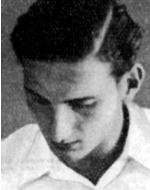Berger, Yitzhak-Meir (Manfred)
Son of Pappe and Joseph, was born on January 10, 1926, in the city of Nuremberg, Germany, and completed his studies at the Gymnasium in the Netherlands. During the Second World War he was hidden by a Christian family. He was active in the resistance against the German occupier, and in his hiding place he translated propaganda material from the Dutch underground into German. He wisely managed to save his family from Nazi claws. At the end of the war he went to agricultural training in southern France and in March 1946 he immigrated to Israel on the “Tel Hai” ship, in the framework of Aliyah Bet. On the ship he discovered his coolness during the storms in Corsica and the island of Crete. Helped bring down lifeboats and encouraged the spirit of the oppressed. When the ship was caught by the British, Yitzhak could not accept the idea that he would be captured by the British and decided to jump from the sea as soon as the ship reached the shores of Haifa. When he was released from the Atlit detention camp, he immigrated to Jerusalem and worked in the graphic department of the Jewish National Fund. He joined the Hagana and often participated in training. Was admired and liked by his friends. Upon the outbreak of the War of Independence, the Haganah was in Jerusalem and was sent to a squad commanders’ course. He served in the Moriah Battalion and participated in operations in Sheikh Jarrah, Wadi Joz and Katamon. He also assumed command of Mount Scopus and the assault of Arabs on the university grounds. The road to Mount Scopus passed through the Arab Sheikh Jarrah neighborhood and when the war broke out, the movement was allowed to mount convoys secured by the British army. On the morning of April 13, 1948, a convoy left for Mount Scopus, after the British promised that the road was open and safe. The convoy encountered an Arab ambush in the Sheikh Jarrah neighborhood and hundreds of Arabs hurled heavy gunfire at it. Some of the vehicles managed to get out and return, but two buses, an ambulance and an escort vehicle were ambushed. For many hours the convoy members fought and tried to prevent the Arabs from approaching the vehicles. Fire from our positions in the city and Mount Scopus, as well as armored vehicles sent to the area, failed to help the convoy. British military forces in the area did not intervene and did nothing to help, despite appeals to them. In the afternoon, the Arabs managed to set fire to two buses on their passengers, and only after evening did the British intervene and rescue the survivors from the trapped vehicles, who fell in the blood convoy of Hadassah doctors and workers on April 13, 1948, and was buried in Sanhedria In Jerusalem. On September 18, 1952, he was put to rest at the military cemetery on Mount Herzl in Jerusalem.
